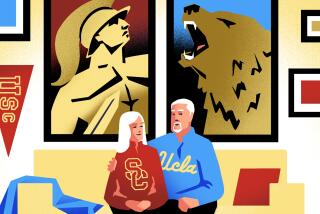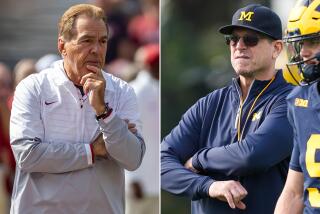SEASON CAPPERS
- Share via
‘The big game.”
Never mind the bowl bids. Don’t worry about the polls. Forget about the records and the winning streaks and the Heisman candidates.
Year in and year out, no game in college football is bigger than the one a team plays against its archrival, very often its closest neighbor. Nothing evokes as much agony as losing bragging rights in the ‘hood.
It doesn’t matter if it’s UCLA-USC, Cal-Stanford, Florida-Florida State or Harvard-Yale, the traditional rivalry is usually the centerpiece of the season. A victory in “the big game” can brighten the darkest of seasons, blur the harsh reality of a losing record. A loss can cast a dark shadow over the brightest of seasons.
A coach can save his job by beating the team down the highway. He can also lose his job if he beats every other team but loses consistently to the team down the highway.
Michigan-Ohio State?
“We peaked for each other,” former Michigan coach Bo Schembechler said in his book, “Bo.” “Some years, we were so emotionally wrung out after that game, I’m surprised we had enough energy to board the plane.
. . . Can you imagine waiting a whole year for one football game? To have your mood for the next 365 days depend on how you did that one cold Saturday afternoon? That’s the way I felt about the Michigan-Ohio State game. . . . It was everything I lived for, everything we all lived for. Lose, and your world was gray. Win, and you were in heaven.”
Texas-Oklahoma?
Said Barry Switzer, who coached at Oklahoma: “When you beat Texas, I don’t care what your won-lost record is, it’s the biggest day of your life. We looked at it as though it were the national championship. I mean, man, when you take a team down that ramp to play Texas, you’d better damn well feel the emotion. When you hit the floor of the Cotton Bowl, there’s electricity. And if you don’t feel it, you ought to go have your saliva checked.”
UCLA-USC?
“It’s not a matter of life and death,” former Bruin coach Red Sanders said. “It’s a little more important than that.”
Stories, stories. Everybody who has ever played in “the big game” has one dating to 1869, when Rutgers played Princeton in the first intercollegiate game. Some of those stories are well known. Some are forgotten. Most are worth retelling.
Space won’t permit that, but here are a few:
The Crusade
The Michigan Wolverines started thinking about beating the Ohio State Buckeyes in 1969 as the gun sounded to end the 1968 game, with Ohio State on top, 50-14.
The Buckeyes started the ’69 game unbeaten, with a national championship within reach .
When Michigan beat Iowa, 51-6, the week before, the Wolverines, still in their uniforms, gathered in the locker room afterward, chanting, “Beat the Bucks! Beat the Bucks!”
They wore the previous year’s score, 50-14, taped to their uniforms all week in practice and were reminded that they were 17-point underdogs.
Once the game began, “It was as if all the energy from a season’s worth of tackles and body-slams had just been released,” Schembechler said.
Michigan won, 24-12, before a frenzied Ann Arbor crowd of 103,588.
Years later, at a banquet attended by Schembechler and Ohio State Coach Woody Hayes, Hayes said that 1969 team had been his best.
And then he yelled, “Damn you, Bo, you will never win a bigger game than that one.”
The Play
The year was 1982, the place was Berkeley, the occasion was the 85th meeting of Cal and Stanford in what they view as the real Big Game.
Stanford kicked a field goal for a 20-19 lead with four seconds left. The celebration spilled onto the field as the teams prepared for the kickoff and Stanford was penalized 15 yards, which meant the Cardinal would kick from the 25-yard line.
In the end zone, Stanford’s band had edged onto the field. Only the game wasn’t over yet.
The Bears, having received, were still alive and moving down the field, thanks to five laterals. As Cal’s Kevin Moen approached the Stanford end zone, all he saw in his way were musicians. After crossing the goal line, he knocked over trombonist Gary Tyrrell in triumph.
Cal won, 25-20, as radio announcer Joe Starkey screamed into his microphone, “The most amazing, sensational, traumatic, heart-rending, exciting, thrilling finish in the history of college football.”
The Replay
Great moments in great rivalries seem to last longer than others. They are played and replayed. Sometimes literally.
Billy Cannon of Louisiana State ran 89 yards for the touchdown that enabled his team to beat archrival Mississippi, 7-3.
The tape of that touchdown run can still be heard on Louisiana radio stations.
Which is amazing, considering that Cannon scored that memorable touchdown in 1959.
The Creek
The first time Oklahoma played its other chief rival, Oklahoma A&M--now; Oklahoma State--the Sooners won, 75-0.
But what was most memorable about that meeting, played in Guthrie, Okla., in 1904, was the fourth play of the game. An A&M; player punted into a stiff wind. The wind caught the fat football of the era, blowing it backward, not only behind the line of scrimmage but beyond the end zone, into adjoining Cottonwood Creek.
Players went into the water after it and Oklahoma’s Ed Cook got his hands on the floating ball. He thrashed his way back to shore and touched the ball down, giving Oklahoma its first score.
It was wet, it was wild, but, under the rules of the day, perfectly legal. Touchdown for Oklahoma.
Dirty Tricks
Everybody and everything gets involved in the big game. At Texas, the team mascot is a longhorn steer named Bevo. In 1916, Texas A&M; beat Texas, 13-0, then stole Bevo, the first of the line, and branded him with the score. At a dinner after Texas had upset the Aggies for the Southwest Conference title in 1920, the teams were served steak. Talk about eating crow. It was Bevo, the portion that bore the shameful 13-0 brand served to the Aggies. Texas players dined on the unblemished side of beef.
There is the Axe, with the Big Game scores inscribed on the plaque it’s mounted on, that is passed back and forth between Cal and Stanford, the winner getting it each year. But with the two schools still debating who won the big band game, the score from that year is changed each time the Axe changes hands. When Cal has it, the score reads 25-20, in its favor. When Stanford has the Axe, the score reads 20-19, Stanford.
For UCLA-USC, the target of big game week has historically been the statue of Tommy Trojan on the USC campus. One year, a group of UCLA commandos nearly cut off the statue’s head before police arrived. A more successful group of commandos rented a helicopter one year and dumped a load of manure on the intrepid Tommy.
“Prior to the 1966 Rose Bowl game against Michigan State . . . Coach [Tommy] Prothro tried to put the game in perspective for us,” said former UCLA quarterback Gary Beban, the school’s only Heisman Trophy winner, “by mentioning eight hundred million people in China who were not concerned with the final score of the game. He never made such a reference prior to a UCLA-USC game, so I have always assumed that they were interested.”
THE RIVALRY
USC vs. UCLA
Saturday, Coliseum
12:30 p.m.
Channel 7
* TRAGEDY AT TEXAS A&M;
A 40-foot tower of logs for traditional bonfire collapses, killing at least 11 students and injuring 28 more. A1
* NO DEPTH ON CHART
Injuries have forced Bruin coaches to spend time scratching out lineup possibilities on paper. D3
More to Read
Go beyond the scoreboard
Get the latest on L.A.'s teams in the daily Sports Report newsletter.
You may occasionally receive promotional content from the Los Angeles Times.










